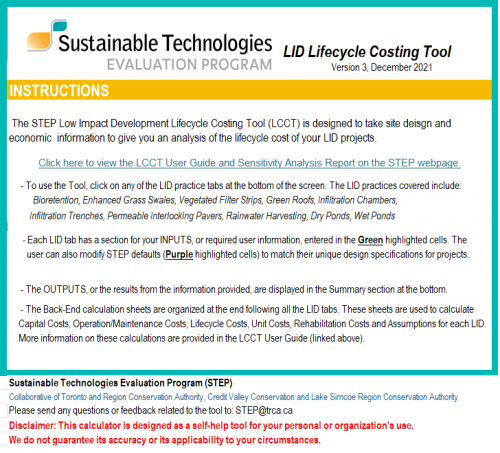Difference between revisions of "Low Impact Development Life Cycle Costing Tool"
Dean Young (talk | contribs) |
Dean Young (talk | contribs) |
||
| Line 35: | Line 35: | ||
*[[LID LCCT: Rainwater Harvesting]] | *[[LID LCCT: Rainwater Harvesting]] | ||
<small>'''Note''': All practice cost estimates are based on a Contributing Drainage Area (CDA) of | <small>'''Note''': All practice cost estimates are based on a Contributing Drainage Area (CDA) of 2000 m<sup>2</sup>, runoff retention or treatment depth of 25 mm, and a drainage period of 72 hours. For infiltration practices, native soil infiltration rates for Full, Partial and No Infiltration Design scenarios were assumed to be 20 mm/h, 10 mm/h and 2 mm/h, respectively, and a safety factor of 2.5 was applied.</small> | ||
==References== | ==References== | ||
Revision as of 14:24, 5 December 2022

Overview[edit]
Accurately estimating the life cycle costs for low impact development (LID) practices can be a costly and time-consuming process. The LID life cycle costing tool (LCCT) facilitates this process and allows users to produce realistic cost estimates based on user-specified LID design and economic information. The LCCT provides cost estimates for the construction, inspection, and maintenance of LID stormwater practices.
Originally released in 2013, the most recent version of the excel-based tool (Version 3.0) includes the following new features and updates:
- Increased transparency and usability. Users can now access the tool’s back-end to modify assumptions, unit costs, design defaults, etc.
- Porous asphalt was added as a LID practice. Additionally, this tab allows for cost estimations for conventional asphalt so that direct comparisons can be made with LID practices.
- Cost estimation for dry ponds has been added to LID practices. Wet ponds are also included as a traditional stormwater management strategy in order to facilitate direct comparisons with LID.
- Updated line costs to 2018 based on RS Means data and information obtained through consultation with suppliers and project managers.
- Refined algorithms to reflect line cost updates and construction practices (i.e., bioretention sizing algorithm based on latest guidance).
- Added a land value option to all BMPs. This allows users to account for land acquisition when required and for opportunity costs when otherwise developable land is used for stormwater management.
- Updated maintenance task schedules using “discretionary maintenance options” and defaults that were based on observations in the field.
- Added a costing curve development module that enables users to develop their own costing curves to be input into the LID-TTT.
- A sensitivity analysis that uses constructed projects to test the tool’s accuracy.
- An LCCT user guide provides a brief introduction to the tool and a demonstration of how it can be used to suit their purposes.
- The LID practices evaluated in the report include bioretention cells, permeable pavement, infiltration trenches and infiltration chambers, enhanced swales, rainwater harvesting and green roofs. bioswales and perforated pipe systems or exfiltration trenches were considered to be similar to bioretention and infiltration trenches, respectively, and therefore were not evaluated as separate practices. The tool does not assess LID-related cost savings related to improved aesthetics, air quality, community livability and other public benefits, as these savings are best evaluated in relation to specific case study examples.
STEP encourages feedback on the LCCT from users and they can provide them below on this page or here at the team's email address: STEP@trca.ca
Practice-specific Life Cycle Costs[edit]
You can find practice-specific life cycle costs per LID BMP as listed below. Each page provides a brief overview of the practice and highlights a design summary cost breakdown discussing construction costs, life cycle costs total, retrofits and operation and maintenance costs associated over both 25 and 50-yr scenarios.
To read more about assumed costs of deign, construction, O&M and associated life cycle costs for each of the modeled LID practices, please see below:
- LID LCCT: Bioretention
- LID LCCT: Permeable Pavements
- LID LCCT: Enhanced Swales
- LID LCCT: Vegetated Filter Strips
- LID LCCT: Underground Infiltration Chamber
- LID LCCT: Infiltration Trench
- LID LCCT: Rainwater Harvesting
Note: All practice cost estimates are based on a Contributing Drainage Area (CDA) of 2000 m2, runoff retention or treatment depth of 25 mm, and a drainage period of 72 hours. For infiltration practices, native soil infiltration rates for Full, Partial and No Infiltration Design scenarios were assumed to be 20 mm/h, 10 mm/h and 2 mm/h, respectively, and a safety factor of 2.5 was applied.
References[edit]
- ↑ TRCA. 2019. Low Impact Development Life Cycle Costing Tool. Accessed 22 November 2022. https://sustainabletechnologies.ca/lid-lcct/